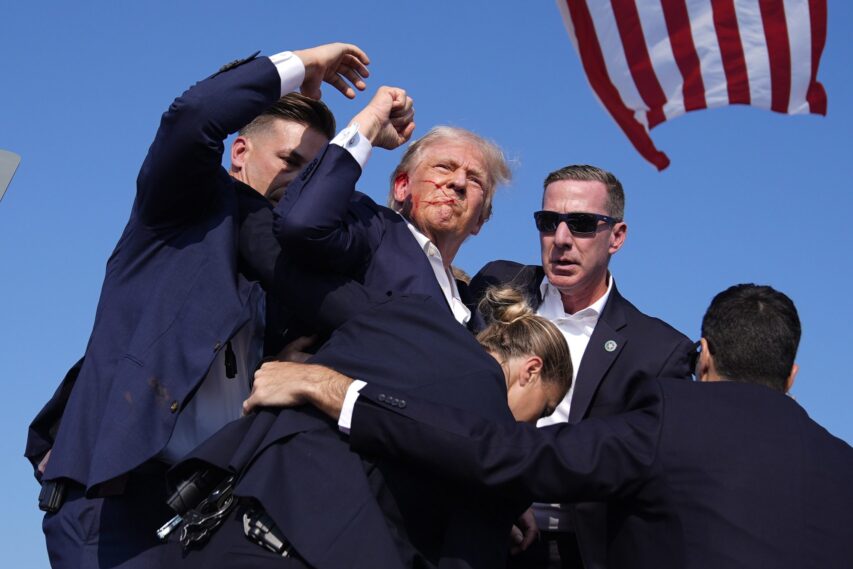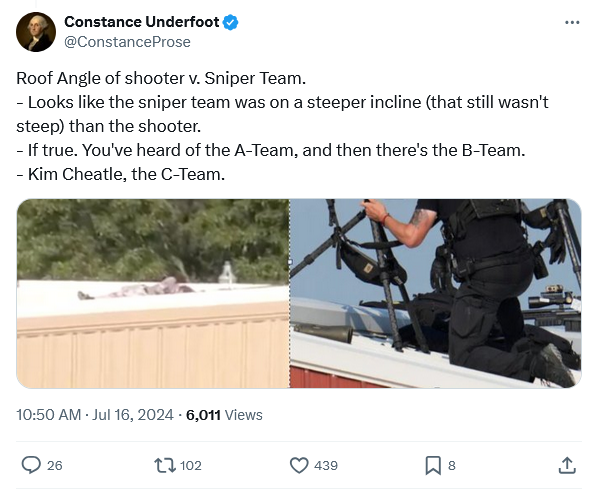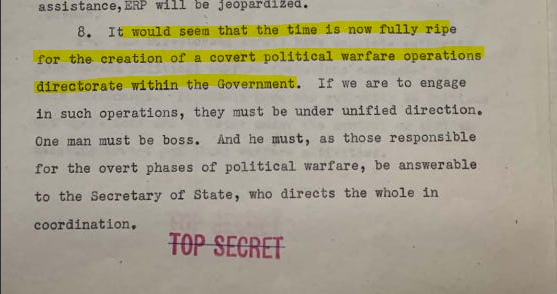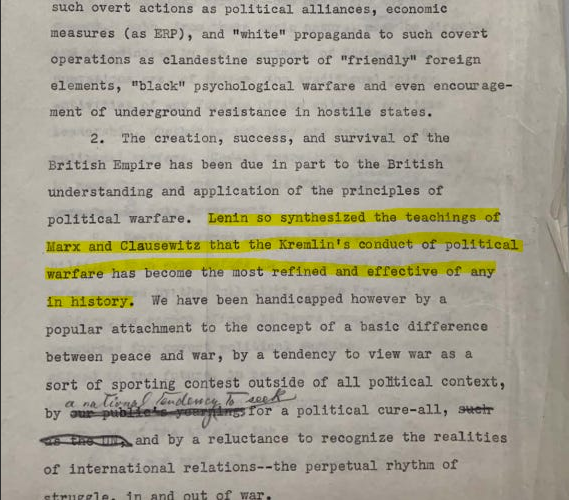The Great War
Published 11 Oct 2024The Mexican Revolution of 1910-1920 was a conflict of shifting alliances and assassinations, peasant revolutionaries, an attack on US soil, and US intervention in Mexico. The decade of struggle cost hundreds of thousands of lives, resulted in new constitutions and governments, and — for some at least — turned bandits into heroes.
(more…)
March 2, 2025
The Mexican Revolution – Bandits Turned Heroes
January 7, 2025
Caesar’s dictatorship and the Ides of March – The Conquered And The Proud 11
Adrian Goldsworthy. Historian and Novelist
Published 31 Jul 2024Continuing “The conquered and the proud”, this time we look at Julius Caesar as dictator in Rome, about his activities and reforms and his murder on the 15th March — The Ides of March — in 44 BC. We talk about Brutus, Cassius and the other conspirators and what motivated them.
August 27, 2024
QotD: Who were the good guys?
The Valkyrie plot was really a thing that happened (the cognoscenti call it the Schwarze Kapelle), and it’s got all the makings of a great spy thriller … except one: There’s no good guy. Claus von Stauffenberg was a better guy than Hitler, I suppose, but that’s a bar so low it’s subterranean. Von Stauffenberg was a Wehrmacht colonel who’d seen action in pretty much every theater up to that point, including the invasions of Poland and Russia. It’s safe to say that one does not rise to the rank of colonel via combat in the Nazi armed forces without being involved in some shady shit. Indeed, as Wiki informs us, von Stauffenberg was fine with the way things ran in Poland, and initially declined to participate in the resistance out of a sense of personal loyalty to the Führer.
A movie can get away with showing mostly shades of gray, but in the case of the Valkyrie plot, both shades are pretty damn close to black.
Nor was the 2008 movie, starring Tom Cruise, an isolated case. A few years earlier, Jude Law and Ed Harris squared off as dueling snipers in Enemy at the Gates … set during the Battle of Stalingrad. Who do you root for, the Nazi or the Commie? The producers opt for “commie”, obviously, but their attempts to humanize the Jude Law character are embarrassing — even if we accept Law’s character as totally apolitical, no movie featuring a political commissar in a vital supporting role, not to mention “cameos” by Khrushchev and Stalin himself, can fail to remind viewers that everyone involved was awful. Even the most gripping battle scenes (and to be fair, some of them were pretty good) can’t make up for the fact that the world would be a far, far better place if they somehow both could’ve lost.
Those are high-level failures, conceptual mistakes, the kind that professional storytellers simply shouldn’t make. Not only that, though, both movies have unforgivable mistakes in the execution, at almost every level. Tom Cruise, for instance, is comically miscast as Stauffenberg. I’ve written before about how weird it is that casting directors seem to obsess over finding actors who look like even obscure historical figures. Cruise looks a bit like Stauffenberg, I guess, but there’s simply no way a guy with his … ummm … distinctive acting style should be anywhere near a historical drama. Tom Cruise only ever really plays Tom Cruise, so “Tom Cruise dressed up as a Nazi” is really jarring.
And that’s before you consider the accents. Maybe Tom Cruise can’t do a German accent, I dunno. I seem to recall he did an Irish accent in a movie once, and that turned out ok, but again, whatever character he was playing was just “Tom Cruise with an Irish accent.” So maybe if you feel you must cast him as a German, letting him use his “natural” American accent is the way to go. But if you’re going to do that, please, for pete’s sake, make everyone else do an American accent, too. I know Kenneth Branagh can do one. So either cast guys who can do the right accent, or, failing that, who can do each other’s accent. Otherwise you get a huge, distracting mess.
Enemy at the Gates was actually worse: Law, Joseph Fiennes (the commissar), and Rachel Weisz (the love interest) all used their native British accents … but they’re different kinds of British accent, at least in Law’s case. Meanwhile, Ed Harris (the Nazi antagonist) uses the “neutral” American accent, while supporting player Ron Perlman, who is American, does a comically over-the-top Russian … as do the guys playing Khrushchev and Stalin. It’s just weird. In both movies, you’ve got supposedly tight groups of friends (or, at least, co-conspirators) talking to each other in wildly different accents. That kind of thing is bad enough in a movie like Robin Hood, Prince of Thieves, which made no pretenses to historical accuracy; it’s movie-destroying in a supposedly serious, historically-based thriller.
Severian, “Storytelling Fail”, Rotten Chestnuts, 2021-07-13.
August 24, 2024
How the CIA eventually got Patrice Lumumba assassinated
The CIA decided early on that the first democratically elected Prime Minister of the Democratic Republic of the Congo was being controlled by their Soviet opponents and needed to be killed:
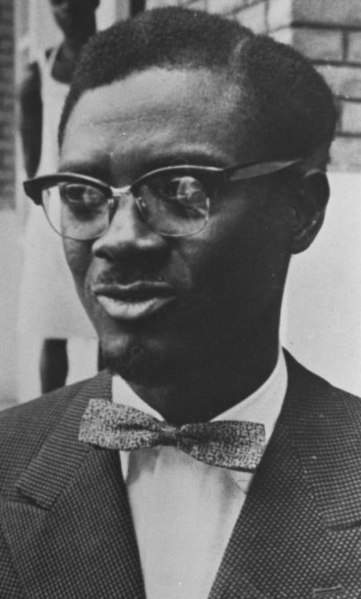
Patrice Émery Lumumba, first Prime Minister of the Democratic Republic of the Congo on 27 December 1960.
Unknown photographer
I’m still making my way through David Talbot’s 2015 book The Devil’s Chessboard, a history that explores the life of CIA Director Allen Dulles and the sordid history of the agency.
There are too many grisly anecdotes to recount showing how the CIA was involved in unlawful and unethical acts all over the world, but one that sticks out was the book’s treatment of Patrice Lumumba, an African nationalist who served as the first prime minister of the Democratic Republic of the Congo before he was killed in 1961 — with a shove from the CIA.
Lumumba was a thorn in the side of the agency, and his left-leaning politics led CIA officials to believe he was a stooge for the USSR (he wasn’t, as the CIA later admitted). So it was determined that Lumumba had to go—one way or the other.
First, a coup was arranged to have the democratically-elected Lumumba, who was demanding full independence for the Congolese people, removed from office and placed under arrest. To this end, the CIA tapped a young military colonel named Joseph Mobutu, who was friendly with Belgian intelligence (the Congo had long been under Belgian colonial rule) and would go on to rule for decades until he was ousted himself in a 1997 rebellion.
Then the CIA began exploring options to eliminate the popular Lumumba. Being the CIA, a single method was not chosen. Instead, various methods were explored to take out the Congolese leader and multiple people were tapped, including a pair of hitmen the agency had hired from Europe’s criminal underworld.
Talbot explains how the CIA equipped one of these cutthroats with a tube of poisoned toothpaste. Why toothpaste? Because one Dr. Ewen Cameron, at the behest of the CIA, had analyzed Lumumba and noted his immaculate white teeth. This led him to suggest a simple way to eliminate the troublesome leader: poison his dental products.
“In the end, the CIA did not go through with the toothpaste plot,” writes Talbot, “apparently deciding that poisoning a popular leader while he was under UN protective custody in his own house would be too flagrant a deed—one that, if traced back to the agency, would lead to unpleasant international repercussions.”
Instead, days before the inauguration of John F. Kennedy, the CIA arranged to have Lumumba chartered off on a plane to Katanga, a province that had broken from the Congo and was ruled by factions hostile to Lumumba.
This all but sealed Lumumba’s fate, CIA officials later testified.
“I think there was a general assumption, once we learned that he had been sent to Katanga, that his goose was cooked,” CIA station chief James Devlin, who helped orchestrate Lumumba’s fall, quipped to the Church Committee years later.
Devlin was right. During his flight to Katanga, Lumumba was beaten to a pulp. Then he was driven by jeep to a farm and beaten by members of rival political factions. The men, Talbot makes clear, had clear ties to US and Belgian intelligence.
“Eventually he was killed, not by our poisons, but beaten to death, apparently by men who had agency cryptonyms and received agency salaries,” said CIA agent John Stockwell, who was sent to the Congo in the aftermath of the assassination.
The Soviets managed a propaganda win out of the CIA’s clumsy wet work, renaming the Peoples’ Friendship University of the USSR (primarily used for training non-Soviet citizens from “fraternal socialist” and “unaligned” nations in Marxist-Leninist views) to the Patrice Lumumba Peoples’ Friendship University.
July 24, 2024
Investigate one assassination attempt, reveal the truth about two earlier assassinations?
I have to admit that I’m skeptical about this, as conspiracies tend to unravel the larger they get (hence the old joke about three being able to keep a secret, if two of them are dead), and the tradition of deathbed confessions has had six decades to reveal itself. However, Benjamin Dichter thinks that a full, honest investigation into the attempt on Donald Trump’s life in Butler, PA would also yield historical dividends on the assassinations of JFK and RFK in the 1960s:
On July 13, 2024, both tragedy and an iconic photograph in American political history emerged from the attempted assassination of the 45th president. Even the harshest critics of Donald J. Trump among the legacy media were forced to acknowledge the moment, which many believe has cemented President Trump as an American icon. This failed assassination has become one of the most pivotal moments in American history, akin to tragedies such as 9/11, Pearl Harbor, and the attempted assassination of Reagan. It is rapidly emerging as a unifying moment for many Americans, signaling that the media’s rhetoric and repeated attempts to label Trump as a dictator, a neo-Nazi, and other unsubstantiated vitriolic claims have gone too far.
Donald Trump, surrounded by Secret Service agents, raises his fist after an attempt on his life during a campaign speech in Butler, PA on 13 July, 2024. One spectator was killed and two others were reported to be in critical condition. The shooter was killed by Pennsylvania State Troopers, according to reports in the succeeding hours.
As a Canadian who has spent much of my life traveling to the US, I have always sensed an underlying, unresolved collective emotional trauma that lingers like morning fog. This trauma stems from the assassinations of President John F. Kennedy and his brother Robert F. Kennedy — both murders believed by the majority of Americans to remain unsolved. More on that in a bit.
A friend of mine, working with the Department of Defense in the domain of security readiness for the US government, has told me the level of incompetence and fumbling of security obligations during Trump’s speech in Butler, PA, was inconceivable. He is not one to be hyperbolic, and we are both believers in Hanlon’s Razor. However, after his long career in the military and then at the Department of Defense, where he learned there is no shortage of incompetence due to government bureaucracy, he insists that the most basic protocols were violated in this case.
How is it possible that anyone could get within 125 yards of a former President and current candidate with a rifle? Not just a small pistol hidden in a pocket, but a large AR-15 platform rifle. “The idea that this could happen uncoordinated is absurd” he said. Even the legacy media is unable to spin their usual ridiculous deflections, which often appear like a frenzy of spawning sharks whenever President Trump is in their midst.
The gravity of this situation has changed everything and heralds a dawn of opportunity for America. For Trump, it is a chance to show the world how the gears of the machine turn. How things really work behind the scene. He is presented with a massive opportunity to seek retribution on behalf of the American people, who are still grappling with unresolved issues from past traumas.
Unlike the tragic assassinations of JFK and Robert F. Kennedy, Trump survived and will likely return to office. Also caught in the chaos were innocent bystanders, notably Corey Comperatore, who sacrificed himself by shielding his family from gunfire, along with two other victims whose injuries were not life-threatening. The innocent victims and their families who will vote in November, make this a situation that hits home with many Americans regardless of party affiliation.
July 20, 2024
When diversity and competence requirements conflict
Janice Fiamengo compares the iconic Trumpian reaction after being wounded by a sniper with the cries for diversity at all costs from others:
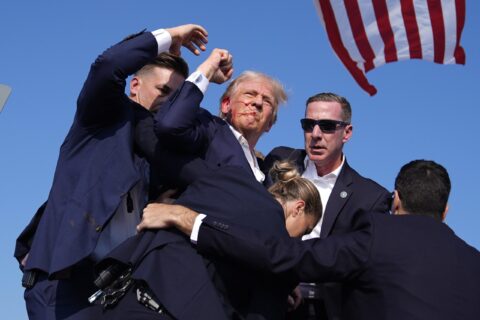
Donald Trump, surrounded by Secret Service agents, raises his fist after an attempt on his life during a campaign speech in Butler, PA on 13 July, 2024.
Many observers have had harsh words for the female Secret Service agents who performed poorly in response to the attempt on Trump’s life last Saturday (see this Wired article for a catalogue of the charges, in which the author cannot muster a single rebuttal). Some noted that Trump’s security detail for the Republican National Convention is now, it appears, exclusively male. And rightly so. There is no equality when bullets start to fly, and it is lethal to pretend there is.
When the first shot rang out, 50-year-old Pennsylvanian firefighter Corey Comperatore is reported to have done what men typically do in such situations: he shielded his wife and daughters, taking a bullet to the head. Women far more rarely perform such acts of self-sacrifice.
Comperatore lost his life because of a multitude of errors on the part of the Secret Service, including a long hesitation by snipers tasked with neutralizing threats. Video shows that at least one of these snipers, seemingly with the gunman in his sites, failed to take action until seconds after the gunman began firing. The agent seemed befuddled, scrambling back when the first shot came. Was he new on the job, inadequately trained, or sub-par in his skills? Or directed not to fire?
I am not equipped to answer these or the many other, darker, questions about the bungled security operation. What can be said for certain is that if some element of the Secret Service was not treasonously complicit in the attempt on Trump’s life, it was certainly massively inadequate to its task of protecting him and others at the rally. The gunman was allowed to gain access to his rooftop shooting position, and Trump was not extracted the moment the shooter’s presence became known.
Director Kimberly A. Cheatle, who expressed to CBS News in interview her concern with “developing and giving opportunities to everyone in our work force, and particularly women“, has a lot to answer for.
Perhaps the women we saw in Trump’s security detail were new recruits helping Cheatle reach her target of 30% women by 2030. They looked amateur, panicked, and unpracticed. One of the women attempting to remove Trump from the stage was simply too small, and hesitant, for the task; she looked at one point as if she were engaged in a group hug at a United Church reconciliation ceremony. (As many have noted, her small stature enabled Trump’s fist-raised gesture of masculine defiance and his exhilarating “Fight! Fight! Fight!”). As Trump was being taken into the security vehicle, the four women surrounding the car looked jumpy and confused, scared and awkward. One woman was visibly unable to holster her gun.
I’ve never seen so many women guarding a former president, and I’ve never seen so many women obviously incapable.
We know that men and women have different strengths and aptitudes. Nearly a decade ago, the United States Marine Corps demonstrated through a year-long study of hundreds of Marines that even women who could pass the physical exam simply could not carry out standard military tasks as efficiently as men. The study found, unsurprisingly, that “The males were more accurate hitting targets, faster at climbing over obstacles, better at avoiding injuries.” The women struggled to carry weapons and ammunition, and even to use the weaponry properly. Women’s higher injury rate was marked: “The well documented comparative disadvantage in upper and lower-body strength resulted in higher fatigue levels of most women, which contributed to greater incidents of overuse injuries such as stress fractures.”
July 18, 2024
July 17, 2024
What do “‘elf an’ safety” concerns have to do with VIP protection details? A lot, it seems
I haven’t been following every twist and turn of the post-assassination-attempt story, but this one really does have me scratching my head. According to the person who had the overall responsibility, the reason the shooter’s location was not properly secured was due to health and safety concerns … for the Secret Service agents, rather than the person they were supposed to be protecting:
Oddly, the roof that the counter-sniper team was occupying visually seems to have a steeper pitch than the one identified as too dangerous:
Since we’re looking at the biggest news event of the year (so far), let’s consider what N.S. Lyons calls “The World Spirit on a Golf Cart“:
I’m going to do something I normally resist doing and offer some hot take thoughts based on recent events. Not on the details of the attempted assassination of Donald Trump specifically (there’s already plenty of that out there), but on what feels like his role in our general moment in time.
In the minutes after Trump dodged a bullet on live television, I joked on Substack Notes that “one does not simply shoot Napoleon”. This proved open to misinterpretation in a few different directions, but what I meant was this:
Napoleon famously led from the front, charging time and again into a hail of bullets and cannon shot, and yet not once was he ever seriously injured. In fact his luck seemed so impervious that he quickly acquired a legendary aura of invincibility. This became part of his overwhelming charisma – meaning not just his social charm but the inexplicable sense of unstoppable destiny that he seemed to exude. This aura proved so captivating to normal men that when he escaped from exile and landed alone in France to … well let’s call it make his “reelection” bid, the army sent to stop him promptly surrendered and switched sides at the mere sight of him.
Napoleon had seemed to become something more than mere mortal: he was a living myth, a “man of destiny” whom Providence had handed some great role to play in history (for good or for ill) and who therefore simply couldn’t be harmed until that role had been fulfilled and the world forever changed. This is why when Hegel witnessed Napoleon he described him with awe as “the world-spirit on horseback”: he seemed truly an “epic” figure, the sweep of history seeming to have become “connected to his own person, [to] occur and be resolved by him” alone, one way or another.
This, it should be noted, used to be the standard way of explaining how the course of the world’s history was shaped. Thus was Alexander understood; thus was Caesar. Only after the Enlightenment and the onset of rationalistic modernity did this mythic view begin to wither away with the broader disenchantment of the world, to be replaced by a depersonalized and mechanistic view of historical causality.
We’re so back now though. Donald Trump has always been something of a bafflingly lucky man, as even his enemies are prone to admit. But witnessing him, in response to whatever whisper of Providence, tilt his head at precisely the right moment and degree to cheat death, I and it apparently many others can’t help but feel like he may be more than lucky – that he now seems as much myth as man.
And when he emerged, shaking off his bodyguards and streaked with blood, to stand and pump his fist in defiance beneath the American flag (as captured by a photographer who just happened to be there at the perfect place and time to reveal an era-defining symbolic image), this was rightly described by awed watchers in the stands and across the nation as “epic”. Maybe epic is the word that comes to their mind only because it’s become internet parlance for “cool shit”. But I suspect that they may mean more than that, that they may be attempting to describe the deeper charisma of someone who really seems to somehow have become a man of destiny, and that they intuited the scene as truly epochal in its meaning.
Earlier, Mark Steyn wondered whether the security failures in Butler were caused deliberately or through utter incompetence:
Let’s cut to the chase — the US Secret Service: In on it? Or just totally crap?
Well, I’ve thought the Secret Service were rubbish not just since we learned of the Cartagena hookers but for at least another decade before that. And increasingly, when it comes to American officialdom — from Kabul to Uvalde — to modify Henry Ford, you can get it in any colour as long as it’s bloated, lavishly over-funded and entirely dysfunctional.
And yet and yet … it’s hard to believe even these guys (plus their bevy of five-foot-two-eyes-of-blue Keystone chorus girls) could be this crap. Assuming for the purposes of argument that the body on the roof is actually that of the perp, a goofball barely out of high school hatched a plan to have Donald Trump’s head explode in close-up on live TV – and, wittingly or otherwise, the world’s most flush money-no-object security state did their best to help him pull it off.
In any accountable “public service”, the Secretary of Homeland Security and the Secret Service gal would already be gone. By this point after the Argentine invasion of the Falklands, Lord Carrington (Foreign Secretary), Sir Humphrey Atkins (Lord Privy Seal) and Richard Luce (Minister for Latin-American Affairs) had already resigned: see my column of September 17th 2001 expressing in my naïve Canadian way mystification as to why, six days later, all the 9/11 flopperoos had not been similarly dispatched.
Because that’s how it goes in the Republic of Non-Accountability, and, if he’s harbouring any doubts about his fitness for the job, Mayorkas figures it can wait till someone takes out RFK Jr. This is a depraved political culture.
What’s the old line? When seconds count, the police are minutes away? Not at a Secret Service event: even when the police are on site in massive overwhelming numbers, they’re still minutes away.
July 15, 2024
Assassins
Political assassination has been thankfully rare in recent decades (with a few exceptions), and the attempted assassination of Donald Trump in Butler, Pennsylvania is the first such attack on a US president or presidential candidate to make the news since Ronald Reagan survived John Hinckley’s attempt in 1981:

Donald Trump, surrounded by Secret Service agents, raises his fist after an attempt on his life during a campaign speech in Butler, PA on 13 July, 2024. One spectator was killed and two others were reported to be in critical condition. The shooter was killed by Pennsylvania State Troopers, according to reports in the succeeding hours.
The attempted assassination of Donald Trump is unfortunately far from the first against an American president. Four presidents have been assassinated (Abraham Lincoln in 1865, James A. Garfield in 1881, William McKinley in 1901, and John F. Kennedy in 1963), but our history has seen numerous other unsuccessful shootings targeting the nation’s chief executive: against Andrew Jackson, Teddy Roosevelt, Franklin D. Roosevelt, Harry Truman, Gerald Ford (twice), Ronald Reagan, and now Trump.
The first of these unsuccessful attempts came against Andrew Jackson in 1835. An unemployed house painter named Richard Lawrence came at Jackson with a pistol while the president was in the U.S. Capitol attending the funeral of South Carolina representative Warren R. Davis. Lawrence pulled the trigger and attendees heard a crack, but the pistol misfired. Jackson turned on Joseph and swung his cane at the assailant, who took out another pistol, which also misfired. A melee ensued with Jackson screaming, “Let me alone! Let me alone! I know where this came from”, suggesting that Jackson’s Whig enemies had sent the assassin. Among those who tried to subdue Joseph was Davy Crockett, who later said of the incident, “I wanted to see the damndest villain in the world and now I have seen him”. Jackson was unharmed but became more paranoid as a result of the close call. It was a contentious period in American politics; the New York Evening Post deemed incident “a sign of the times.” Joseph spent the rest of his life in a mental institution.
The next three shootings of presidents were unfortunately successful ones; it’s remarkable to consider now that these three assassinations took place over just 36 years, from 1865 to 1901. (What must Americans have thought of “our democracy” then?) The next failed attempt did not come until Teddy Roosevelt’s ill-fated effort to reclaim the presidency in 1912 as a third party candidate. In October of that year, Roosevelt was campaigning in Milwaukee — the site of this year’s Republican convention — when a man named Joseph Schrank shot the former president in the chest. Roosevelt was fortunate that his folded 50-page speech was in his chest pocket and slowed the bullet. The bullet did pierce Roosevelt’s chest but did not penetrate too deeply. The crowd attacked Schrank, but Roosevelt asked that they not harm him, which probably saved Schrank’s life. Roosevelt then went ahead with his speech, famously saying, “it takes more than that to kill a bull moose”. This event has perhaps the most similarities to the Trump shooting, as both Trump and TR were ex-presidents looking to return to the White House, and both Trump and Roosevelt showed defiance after being bloodied.
TR’s cousin Franklin was president-elect in February 1933 when an anarchist named Giuseppe Zangara fired five shots at him and Chicago Mayor Anton Cermak in Miami. The would-be assassin missed Roosevelt but hit Cermak and four other people. Roosevelt was likely saved by Miami housewife Lillian Cross, who pushed Zangara’s arm as he was firing. A gravely wounded Cermak told Roosevelt, “I’m glad it was me instead of you”. He died on March 6, two days after hearing Roosevelt’s inaugural address over the radio. Zangara was executed by electric chair two weeks later.
[…]
Before the Trump attack, the most recent shooting of a president was John Hinckley’s attack on Ronald Reagan in 1981. Reagan was early in his first term and was leaving a speech at the Washington Hilton (now referred to as the Hinckley Hilton by Washingtonians), when Hinckley opened fire, hitting Reagan press secretary Jim Brady, Secret Service agent Tim McCarthy, and DC police officer Thomas Delahanty. Reagan’s protective detail threw him to the floor of his limousine and, thinking he was unharmed, took off back for the White House. Like Ford, Reagan did not like being under a pile and thought the agents had broken his rib. When the president coughed up blood, agent Jerry Parr recognized that Reagan had been hit as well and immediately redirected the limo to George Washington Hospital. This decision saved the president’s life. Even so, it was a close call. A paramedic thought upon seeing a gray-colored Reagan, “My God, he’s code city”, ER lingo for someone who isn’t going to make it.
I have to admit to knowing a bit more than the average person about prior presidential assassination attempts thanks to Stephen Sondheim’s soundtrack to the musical Assassins, which I’ve enjoyed listening to many times over the years.
Niall Ferguson on the historical context of political assassinations (the rest of the article is behind the paywall:
“There was a reason why Rome of Julius Caesar and Florence of the Medici were such dangerous places. Assassination was a feature, not a bug, of republican political systems. However, modern American medicine and the overblown security provided to presidents and former presidents together make it quite likely that both candidates will make it to November 5.”
I wrote those words on July 2. Eleven days later, events proved me both right — assassination is part and parcel of republican political systems — and wrong: this has ceased to be true of the United States.
What happened in Butler, Pennsylvania, on the evening of July 13, is in equal measure shocking and baffling. An inch or two further to the left and the bullet that grazed Donald Trump’s ear would have penetrated his skull and very likely killed him. A slight gust of wind, a tremor of the assassin’s hand, an unexpected move by the former president — for whatever tiny reason, Trump lived to fight another day.
The shooter, Thomas Matthew Crooks, a 20-year-old man from nearby Bethel Park, was a registered Republican but had made a $15 donation to the liberal ActBlue political action committee on the day of Joe Biden’s inauguration, when he was 17. Even more puzzling, this young man (who was barely a teenager when Trump was elected in 2016) was able to take several clear shots at the 45th president from the roof of a factory 130 yards away from the stage of Trump’s rally.
How did the Secret Service snipers stationed just 430 feet away not spot Crooks climbing into position on the roof, when at least one member of the public did see him and claimed that he had warned them? It is hard to think of a good explanation.
And what of the consequences? There are those who would have you believe that history is governed by vast impersonal cycles and that events such as this are mere epiphenomena, historical trivia. It is a claim as old as it is false.
The editors at The Line suspect the US Presidential election has now been decided months before any ballots are cast:
The prospect of someone deciding to take the rhetoric to its most extreme albeit logical conclusion — if Trump is a threat to life as we know it, the threat must be ended — cannot come as a surprise. At this time, we don’t know much about the 20-year-old shooter, Thomas Matthew Crooks, beyond his name, the fact that he was a registered Republican but, also, a one-time donor to a progressive political action committee. We await more information, and hope there aren’t many more like him waiting to try again, or retaliate against a Democratic politician.
For now, we at The Line are pondering what’s next. July 13, 2024 is going to be one of those days that future historians look back upon with a certain wistfulness. If the wind was a little harder, a bullet lands a few inches in another direction, and Donald Trump is dead. In this timeline, though, the shooter missed, and now America is going to witness first hand the problems with relying on violence to secure political outcomes. Namely, it very often backfires.
Because we’ve taken the other fork in the road. We now exist in the other timeline of history — the one in which Donald Trump is now the far-and-away favourite to win a second term.
We could be wrong about this. No one can predict the future, and there are lots of scenarios still unplayed out. Does Biden step down in favour of Kamala Harris? Does the shooting turn out to be a hoax perpetrated by Trump or his supporters? Does Trump suffer a heart attack between now and November? Does someone else get shot? Any of these possibilities is still available, and any one could further change the outcome.
However, at this moment in time, it was hard for us to look at the picture of Trump standing up once the bullets had struck, demanding to be seen by the crowd even as his Secret Service detail tries to get him off the stage, pumping his fist in the air, all framed by an American flag, and think anything but “Well, that’s the ballgame.”
The Line is no fan of Trump, but we are also political observers, and Trump’s handling of the assassination attempt, as political showmanship, was absolutely perfect. Trump displayed an incredible presence of mind in the midst of mortal peril. While the echoes of the gunshots were still ringing, he understood that he needed to forgo some small degree of further protection in order to show his supporters — and the world — that he was fine. No one has to like the guy, or ignore the real risks he poses both to American and Canada, but we do have to respect how he handled that moment, if nothing else. It demonstrated calm nerves and competency under literal fire.
The response shored up Trump’s strengths in a way that highlighted Joe Biden’s comparative frailty. The shooting will absolutely supercharge Trump’s supporters, his base, his cult. There’s no coming back from it.
We don’t know what more to say here, folks. For the record, we at The Line rule out nothing at this early juncture. But if the momentum of history holds on its current track, there’s a very good chance that the next American election is over weeks before anyone bothers to cast a ballot.
June 4, 2024
Assassination-to-order, or war by other means
I was not well-informed about the goings-on within Vladimir Putin’s Russia even before the Russo-Ukrainian war went into high gear and disrupted all information from that part of the world and I hear much but trust nothing I’ve been hearing since then. kulak, on the other hand, seems to have paid much closer attention to Russian internal affairs, including one particular political assassination:
On August 20, 2022, 29 year old Daria Dugina was killed in a car bombing on the outskirts of Moscow. The bomb, it was widely agreed, had been intended for her father the famed/infamous Russian philosopher Alexander Dugin (whose works are now shockingly hard to get in English and appears on my “Real Banned Books List“), and while there were lots of deflections and denials, it was fairly widely agreed the plot had been carried out with US and UK backing by Ukrainian-aligned insurgents and agents within Russia.
Indeed many US aligned “Journalists”, “Open Source Intelligence” types, Bellingcat-associated influencers, and other CIA-aligned carve outs openly CELEBRATED the death of Daria, since she had been involved in Putin-aligned political youth organizing.
Of course, the fact political volunteers and door knockers have NEVER been considered legitimate military targets, nor the fact the real target was a PHILOSOPHER and everything he had ever done would have been perfectly legal to do even within the United States under the auspices of the first amendment … that somehow never occurred to these commentators. Nor the wider US intellectual class, and somehow neither did the natural logical conclusion.
Russia is by and large NOT run by its political organizers and academics. You could probably kill 1000 Russian university professors and it wouldn’t unbalance the Russian state too extraordinarily. Russia is run by a combination of old Soviet secret policemen, gangsters, and crooked/”reformed” oligarchs all attempting to reorganize themselves into a somewhat respectable upper-class, with a blend of impressive and farcical results.
Before he was killed in an internal power struggle the former head of Wagner PMC Yevgeny Prigozhin embodied this, turning from a St. Petersburg gangster, to a prisoner, to a (definitely money laundering) caterer for the presidential palace, to the head of a PMC mercenary company. Every prominent person in Russia has a career like this Right down to Putin going from a KGB officer, to a gangster/political fixer, to president … Every elite member of Russian society is basically leading a life ripped right from Grand Theft Auto IV, complete with the eternal struggles of trying to “go legit” and formalize everything as a normal upper-class elite, to being dragged back into gangsterism or even Soviet power struggles by their complex past.
Put simply the actual Russian Elite are not people very intimidated by assassination. They’ve all known people to be killed in power struggles, espionage, and criminal altercations, and are used to the anxiety that death might wait for them around the corner. And the US and Ukraine lashing out at academics who might be intimidated doesn’t really affect them.
However, if the Russian state did the logical tit-for-tat escalation and responded in kind … that would shake America to its knees. America actually IS run by its academics, political organizers, and bureaucrats. And almost none of the people with power have a gangster or KGB agent’s stoic familiarity with death and danger.
Killing a Russian Academics daughter did very little to the Russian state… It’d be a very different story for Russia’s armed agents to do the same in America and kill Chelsea Clinton, daughter of current Columbia professor Hillary Clinton.
It’s be a very different story if Russia assassinated Brookings senior fellow Robert Kagan, husband of former under-secretary of state Victoria Nuland. Or any number of Harvard, Stanford, Yale or Princeton political philosophers or International Relations commentators, or members of their family.
One can imagine the headlines if John Hopkins and RAND fellow Francis Fukuyama was so killed:
“It is the end of Fukuyama”
– History
And again remember, though the various income streams of the US elite may resemble embezzlement, protection rackets, and money laundering … these aren’t gangsters. These are complacent, highly agreeable, shockingly unoriginal and cowardly … academics and bureaucrats.
Indeed one can imagine Putin weighing the risk of such a reprisal and then deciding against it, not out of ethical concerns, but because the American ruling class is too unpredictable and prone to womanly hysterias.
Indeed amongst the few senior American and Ukrainian officials who knew of the attack beforehand you can imagine them salivating that Putin might respond in kind and the subsequent freakout might commit the US to joining the war (one of the few scenarios where Ukraine could possible survive against their overwhelming odds).
February 19, 2024
The CIA’s covert operations … as inspired by Vladimir Lenin
Along with most people who’ve been paying attention to history since the start of the Cold War, I hold the CIA in dubious regard. They seem to have been involved in so many underhanded escapades in countries around the world — certainly by reputation, if not in reality — that they stand almost in direct opposition to how most Americans liked to think of their country. Jon Miltimore thinks that among their inspirations was the founder of the Soviet Union himself:
I bring all of this up because I recently came across an old document of some significance that I’d never heard of before titled, “The Inauguration of Organized Political Warfare“.
It was authored by George Kennan, the State Department Policy Planning Director who’d go on to be a successful US diplomat, for the National Security Council (which governed the CIA), and the document explained how the US government had to mobilize national resources “for covert political warfare” to combat the Soviet Union.
Kennan was not, in my opinion, a bad man. He had good instincts and sound motives, at least compared to others in the US intelligence apparatus. He was an early opponent of the Vietnam War and later was one of the first diplomatic leaders to warn against the US policy of expanding NATO up to Russia’s doorstep, something he predicted would be “the most fateful error of American policy in the entire post-cold-war era”.
That said, it’s clear that Kennan was not appalled by the Soviet Union’s use of covert political warfare. He was impressed by it.
“Lenin so synthesized the teachings of Marx and Clausewitz that the Kremlin’s conduct of political warfare has become the most refined and effective of any in history,” Kennan wrote in the document.
We have been handicapped however by a popular attachment to the concept of a basic difference between peace and war, by a tendency to view war as a sort of sporting context outside of all political context, by a national tendency to seek for a political cure-all, and by a reluctance to recognize the realities of international relations — the perpetual rhythm of [struggle, in and out of war].
The document is fascinating because it appears to mark the genesis of the US government’s first formal steps into the world of political warfare — a well-documented history that includes toppling governments, assassinating world leaders, tipping elections, and torturing enemies.
All of these efforts, of course, initially targeted external parties and countries to serve “the national interest”.
This is no longer the case. The CIA, NSA, and other intelligence agencies no longer restrict their covert political warfare to foreign states, and I’m not talking about just Operation Mockingbird and other domestic propaganda efforts.
The CIA is clearly putting its thumb on the scales of US elections in ways that should terrify all Americans.
December 18, 2023
QotD: A short history of the (long) Fifth Century
The chaotic nature of the fragmentation of the Western Roman Empire makes a short recounting of its history difficult but a sense of chronology and how this all played out is going to be necessary so I will try to just hit the highlights.
First, its important to understand that the Roman Empire of the fourth and fifth centuries was not the Roman Empire of the first and second centuries (all AD, to be clear). From 235 to 284, Rome had suffered a seemingly endless series of civil wars, waged against the backdrop of worsening security situations on the Rhine/Danube frontier and a peer conflict in the east against the Sassanid Empire. These wars clearly caused trade and economic disruptions as well as security problems and so the Roman Empire that emerges from the crisis under the rule of Diocletian (r. 284-305), while still powerful and rich by ancient standards, was not as powerful or as rich as in the first two centuries and also had substantially more difficult security problems. And the Romans subsequently are never quite able to shake the habit of regular civil wars.
One of Diocletian’s solutions to this problem was to attempt to split the job of running the empire between multiple emperors; Diocletian wanted a four emperor system (the “tetrarchy” or “rule of four”) but what stuck among his successors, particular Constantine (r. 306-337) and his family (who ruled till 363), was an east-west administrative divide, with one emperor in the east and one in the west, both in theory cooperating with each other ruling a single coherent empire. While this was supposed to be a purely administrative divide, in practice, as time went on, the two halves increasing had to make do with their own revenues, armies and administration; this proved catastrophic for the western half, which had less of all of these things (if you are wondering why the East didn’t ride to the rescue, the answer is that great power conflict with the Sassanids). In any event, with the death of Theodosius I in 395, the division of the empire became permanent; never again would one man rule both halves.
We’re going to focus here almost entirely on the western half of the empire […]
The situation on the Rhine/Danube frontier was complex. The peoples on the other side of the frontier were not strangers to Roman power; indeed they had been trading, interacting and occasionally raiding and fighting over the borders for some time. That was actually part of the Roman security problem: familiarity had begun to erode the Roman qualitative advantage which had allowed smaller professional Roman armies to consistently win fights on the frontier. The Germanic peoples on the other side had begun to adopt large political organizations (kingdoms, not tribes) and gained familiarity with Roman tactics and weapons. At the same time, population movements (particularly by the Huns) further east in Europe and on the Eurasian Steppe began creating pressure to push these “barbarians” into the empire. This was not necessarily a bad thing: the Romans, after conflict and plague in the late second and third centuries, needed troops and they needed farmers and these “barbarians” could supply both. But […] the Romans make a catastrophic mistake here: instead of reviving the Roman tradition of incorporation, they insisted on effectively permanent apartness for the new arrivals, even when they came – as most would – with initial Roman approval.
This problem blows up in 378 in an event – the Battle of Adrianople – which marks the beginning of the “decline and fall” and thus the start of our “long fifth century”. The Goths, a Germanic-language speaking people, pressured by the Huns had sought entry into Roman territory; the emperor in the East, Valens, agreed because he needed soldiers and farmers and the Goths might well be both. Local officials, however, mistreated the arriving Goth refugees leading to clashes and then a revolt; precisely because the Goths hadn’t been incorporated into the Roman military or civil system (they were settled with their own kings as “allies” – foederati – within Roman territory), when they revolted, they revolted as a united people under arms. The army sent to fight them, under Valens, engaged foolishly before reinforcements could arrive from the West and was defeated.
In the aftermath of the defeat, the Goths moved to settle in the Balkans and it would subsequently prove impossible for the Romans to move them out. Part of the reason for that was that the Romans themselves were hardly unified. I don’t want to get too deep in the weeds here except to note that usurpers and assassinations among the Roman elite are common in this period, which generally prevented any kind of unified Roman response. In particular, it leads Roman leaders (both generals and emperors) desperate for troops, often to fight civil wars against each other, to rely heavily on Gothic (and later other “barbarian”) war leaders. Those leaders, often the kings of their own peoples, were not generally looking to burn the empire down, but were looking to create a place for themselves in it and so understandably tended to militate for their own independence and recognition.
Indeed, it was in the context of these sorts of internal squabbles that Rome is first sacked, in 410 by the Visigothic leader Alaric. Alaric was not some wild-eyed barbarian freshly piled over the frontier, but a Roman commander who had joined the Roman army in 392 and probably rose to become king of the Visigoths as well in 395. Alaric had spent much of the decade before 410 alternately feuding with and working under Stilicho, a Romanized Vandal, who had been a key officer under the emperor Theodosius I (r. 379-395) and a major power-player after his death because he controlled Honorius, the young emperor in the West. Honorius’ decision to arrest and execute Stilicho in 408 seems to have precipitated Alaric’s move against Rome. Alaric’s aim was not to destroy Rome, but to get control of Honorius, in particular to get supplies and recognition from him.
That pattern: Roman emperors, generals and foederati kings – all notionally members of the Roman Empire – feuding, was the pattern that would steadily disassemble the Roman Empire in the west. Successful efforts to reassert the direct control of the emperors on foederati territory naturally created resentment among the foederati leaders but also dangerous rivalries in the imperial court; thus Flavius Aetius, a Roman general, after stopping Attila and assembling a coalition of Visigoths, Franks, Saxons and Burgundians, was assassinated by his own emperor, Valentinian III in 454, who was in turn promptly assassinated by Aetius’ supporters, leading to another crippling succession dispute in which the foederati leaders emerged as crucial power-brokers. Majorian (r. 457-461) looked during his reign like he might be able to reverse this fragmentation, but his efforts at reform offended the senatorial aristocracy in Rome, who then supported the foederati leader Ricimer (half-Seubic, half-Visigoth but also quite Romanized) in killing Majorian and putting the weak Libius Severus (r. 461-465) on the throne. The final act of all of this comes in 476 when another of these “barbarian” leaders, Odoacer, deposed the latest and weakest Roman emperor, the boy Romulus Augustus (generally called Romulus Augustulus – the “little” Augustus) and what was left of the Roman Empire in the west ceased to exist in practice (Odoacer offered to submit to the authority of the Roman Emperor in the East, though one doubts his real sincerity). Augustulus seems to have taken it fairly well – he retired to an estate in Campania originally built by the late Republican Roman general Lucius Licinius Lucullus and lived out his life there in leisure.
The point I want to draw out in all of this is that it is not the case that the Roman Empire in the west was swept over by some destructive military tide. Instead the process here is one in which the parts of the western Roman Empire steadily fragment apart as central control weakens: the empire isn’t destroyed from outside, but comes apart from within. While many of the key actors in that are the “barbarian” foederati generals and kings, many are Romans and indeed (as we’ll see next time) there were Romans on both sides of those fissures. Guy Halsall, in Barbarian Migrations and the Roman West (2007) makes this point, that the western Empire is taken apart by actors within the empire, who are largely committed to the empire, acting to enhance their own position within a system the end of which they could not imagine.
It is perhaps too much to suggest the Roman Empire merely drifted apart peacefully – there was quite a bit of violence here and actors in the old Roman “center” clearly recognized that something was coming apart and made violent efforts to put it back together (as Halsall notes, “The West did not drift hopelessly towards its inevitable fate. It went down kicking, gouging and screaming”) – but it tore apart from the inside rather than being violently overrun from the outside by wholly alien forces.
Bret Devereaux, “Collections: Rome: Decline and Fall? Part I: Words”, A Collection of Unmitigated Pedantry, 2022-01-14.
July 21, 2023
The Führer Adolf Hitler is Dead!?
World War Two
Published 20 Jul 2023Stauffenberg, Olbricht and the plotters launch Operation Valkyrie. The army moves in to seize power, troops surround the government quarter in Berlin, and Joseph Goebbels is arrested. But things start going wrong pretty much immediately and far away in East Prussia the Nazi fightback begins.
(more…)
July 14, 2023
How Hitler Approved His Own Assassination – WW2 Documentary Special
World War Two
Published 13 Jul 2023So far, the German resistance haven’t had much luck with their attempts to kill the Führer, Adolf Hitler. But now, the German war hero Claus von Stauffenberg, together with Friedrich Olbricht and Henning von Tresckow, drives the resistance forward. It’s time to kill Hitler. It’s time for Operation Valkyrie.
(more…)
May 28, 2023
This Gun Could Reach Space
Real Engineering
Published 18 Feb 2023
(more…)

